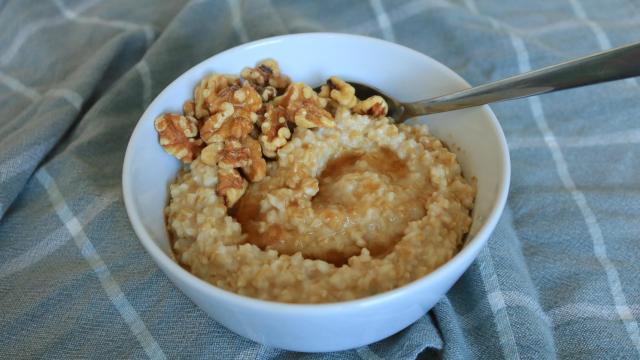Oatmeal lovers, I have good news for you. If you got excited when overnight oats were added to your groat repertoire, you might not be able to contain yourself when you find out there is yet another way to prepare them. Because it turns out that, under the right conditions, oatmeal can be prepared in your rice cooker. Provided it’s a fancy one and you have some time on your hands.
Who is the oatmeal-in-rice cooker method for?
This cooking method is a great solution for multitaskers and folks on a tight morning schedule, and it’s particularly wonderful if you’re looking to feed a group of three to six without risking an oh-shit-I-left-the-oats-cooking moment. Be aware, this works best with a more advanced rice cooker that has several settings (we’ll talk more about that later).
Oatmeal and I have an on-again, off-again relationship, so I never make more than one serving, and only when stirring it occasionally while I wait won’t get in the way of my schedule. Cooking oats in the rice cooker can be largely hands-off and, like a slow cooker, it’s perfectly safe to walk away from them while the cooker does its thing. Not only is this easy but it enables you to fully immerse yourself in other tasks while you wait.
How do you make oatmeal in a rice cooker?
I have a small rice cooker that makes about four cups of cooked rice. Oats act similarly to rice in that they continually absorb water until they burst and break apart. This being the case, plan enough room for the oats to swell as usual, and be just as accurate in measuring your ratio of liquid to oats. I used Bob’s Red Mill steel cut oats (Golden Spurtle fans amirite?) and followed the cooking ratio listed on the back of the package. One cup of oats to two and a half cups of water worked well for me, although you can cut down on the liquid by up to a half cup if you prefer a stiffer porridge.
It works, but there’s a downside
The resulting oatmeal was as perfect as it gets–tender and piping hot, with a pliable yet thick consistency. However, I hit a couple snags along the way. As I mentioned earlier, I have a small rice cooker. It’s old. Also it’s very basic. (OK, fine, my mum got it for me when I was in college and it still works, so why would I buy one of these cool ones with all the different settings?)
My rice cooker offers a choice between “on” and “warm” and until I threw oatmeal into it, those were all the settings I needed. Naturally, I set it to “on” and walked away. I happened to be browsing my spice cabinet 20 minutes later when I heard a distinct sizzling and gurgling sound. Turns out my rice cooker was spewing out starchy oat juice. If you’ve ever boiled potatoes, pasta, or other high starch foods and accidentally covered it with a lid for too long, then you know what it looked like: The bubbles from the boiling water become starch bubbles, which build upon each other and eventually push themselves out of the pot. You must boil it uncovered, or semi-covered, to avoid this, but that’s not really an option for a rice cooker, since it relies on contained steam to ensure even cooking. This makes the rice cooker option work best only for those that have more settings than “on” and “warm.”
If you have a rice cooker with only two settings, then you have two options. You can cook it on high (which is “on” for me) for 10-20 minutes, while keeping a close eye on it, and then reduce the heat to “warm” (to avoid the oat volcano) for an additional 50 minutes, stirring occasionally. The other option is to set it to “warm” from the start, and wait for a sizable portion of your life to creep by before you get to enjoy your oatmeal. Sadly, this limitation turned the hands-off experience into your average oatmeal preparation, with an additional side of oatmeal-slime clean up.
Another downside is time. This method of cooking oatmeal isn’t as fast as making it in a pot on the stove top; depending on the type of appliance you’re working with, the low setting could take over an hour to cook. Ultimately, I think this method makes the most sense for making overnight oats, the truest set-it-and-forget-it oatmeal. Although I won’t be filling my basic rice cooker with groats again, under the right circumstances, I could see why it might excite some oatmeal enthusiasts out there.

Leave a Reply
You must be logged in to post a comment.